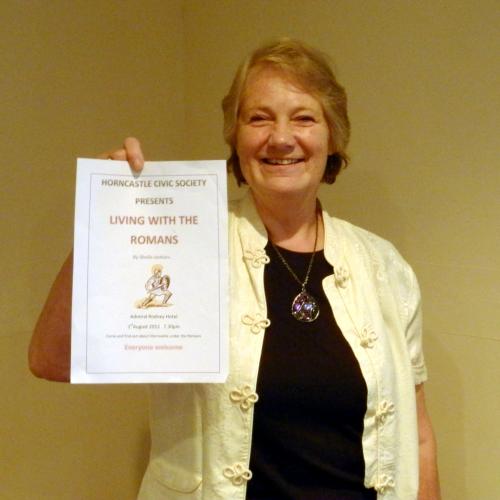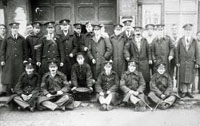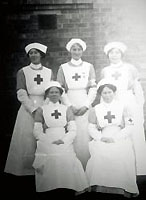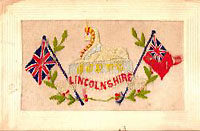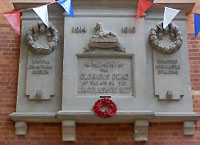Horncastle Heritage Open Days 2021
From 10th to the 13th September will see a host of events across Horncastle, with talks, tours, exhibitions and activities for the whole family. As part of Lincolnshire Heritage Open Days, this year we're celebrating Lincolnshire's untold stories and voices unheard.
The Society is organising three events:
 Horncastle's Roman Walls Revealed
Horncastle's Roman Walls Revealed
Sat 11th
Discover the story of Horncastle's Roman walls and the recent conservation work to save them.
Guided tours (BOOKING ESSENTIAL) on Saturday 11th September at 10am, 11:30am, 1pm and 2:30pm and includes several parts that are not are not usually publicly accessible.
Click here to book your place.
Pros and Cons: the lives of women in the Victorian period
Fri 10th, Sat 11th and Sun 12th 10am-4pm
Joseph Banks Centre, Bridge Street, Horncastle LN9 5HZ
Together with the Joseph Banks Society we take a fascinating look at the lives of local women at all levels in society, from professionals and artisans to convicts transported overseas.
Join us for an exhibition at the Joseph Banks Centre which has recently reopened as a natural history and heritage museum.
Together with the Horncastle History & Heritage Society, we will have displays and interpretations
There will also be guided town walks which can be booked nearer the time via www.horncastlej
Online event
To mark 50 years since the railway closed, explore its history from home with an interactive digital 'story map', or pick up a copy of our new trail leaflet from the Centre for a self-guided walk/cycle.
Printed Spa Trail leaflets available for collection during normal opening hours at the Joseph Banks Centre.
Story Map accessible online every day from 11th September via https://arcg.is/Pevmv
Other events in Horncastle for the festival include
Forgotten Voices of the Past and Present - The Wong Day Services
Fri 10th, Mon 13th, Tue 14th 10am-3pm
The Wong Day Service, 11 The Wong, Horncastle, LN9 6EB
St Mary's Church
Sat 11th 10am-4pm, Sun 12th 12 noon-4pm
Church Lane, LN9 5HW
 St Mary's Church The third church built on the site. Completed around 1160, the oldest part is the tower. Nearby parts of the Roman wall. Connections with Alfred, Lord Tennyson, the Dymoke family (King’s Champion) and John Franklin. Beautiful stained glass, ten guilded angels in the nave roof, lepers’ squint, medieval scythes (linked to the War of the Roses or the Lincolnshire Rising).
St Mary's Church The third church built on the site. Completed around 1160, the oldest part is the tower. Nearby parts of the Roman wall. Connections with Alfred, Lord Tennyson, the Dymoke family (King’s Champion) and John Franklin. Beautiful stained glass, ten guilded angels in the nave roof, lepers’ squint, medieval scythes (linked to the War of the Roses or the Lincolnshire Rising).
Methodist Church
Sat 11th 10am- 12noon
Queen Street, Horncastle, LN9 6BD
Architecturally the Methodist Church is clearly a mid-century building, but there’s a long history of Methodism in Horncastle and on this site. The previous building (1870) was found to be unsafe and was replaced in 1965. John Wesley himself visited the area and preached in Horncastle Market Square in 1779. Our building comprises various halls and rooms for hire.
Come along and sit awhile in this special place, a peaceful and calming atmosphere is evident in the chapel. Many activities here are run by church members and the community, for all age groups.
Lincolnshire Wildlife Trust's Gardens
Lincolnshire Wildlife Trust, Banovallum House, Manor House Street, LN9 5HF
Excellent talk on Thomas Sully by Colin Gascoyne, which had been very well researched. It talked about his very interesting life which started in Horncastle and moved via Edinburgh to America, where he worked tremendously hard to become the foremost portrait painter in America at that time. He painted many Presidents and Military heroes as well as Society ladies and theatrical stars. He also came over as a thoroughly good person who was very family orientated and who loved his work and was constantly trying to improve at what was a very difficult time in America. Colin will follow up in July with a further talk concentrating more on his art works.
We hope to add some articles to our website shortly on Thomas Sully and intend to erect a blue plaque in the town to commemorate his birth here.
On 18th October 2018, Members of the Society visited the IBCC in Lncoln which was opened last year.
The decision to visit was a follow on from the talk given by Dr Dan Ellin in July about the centre.
Members were few in number as several organisations in the town had already visited the site. However, the Soceity had its usualy good luck with the weather and the day was gloriously sunny.
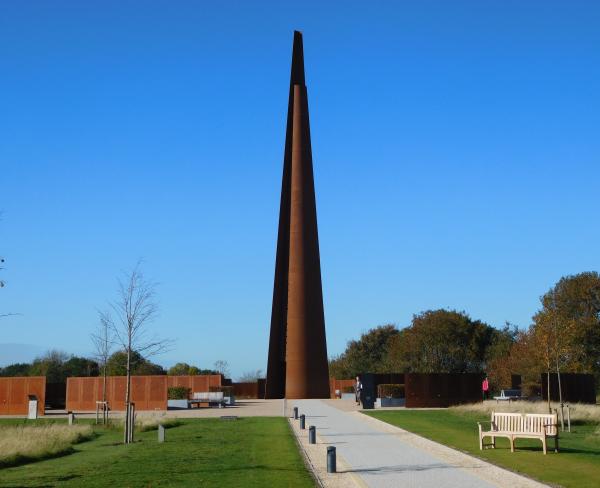
An excellent guide took us around the outside and explained how the memorial came about and told some anecdotes about the airmen.
We then went inside and had lunch and visited the extremey interesting displays and interactive areas.
On Saturday 14th July 2018, a Blue Plaque to Annie Dixon was unveiled at the site of her family home, 40 East Street Horncastle.
The unveiling took place in the garden of the house, which is now the home of Lady Sally Bryce-Gordyne, one of the Society's members. Francis Dymoke, the Society's Patron, unveiled the plaque and proposed a toast to Annie Dixon. This was followd by afternoon tea in this delightful setting.
It was felt very appropriate that in the year we are remembering Women's achievements, that we remember this lady who was the foremost miniature portrait artist of her day, and who painted many of the Royal family and the 'great and the good' of the Nation. A list of the 222 painting that she exhibited at the Royal Academy was on display which read like a 'Who's Who' of the time.
The Usher Gallery were kind evough to send along an actual miniature of Annie's which was of Mary Tennyson and it was delightful to see her actual work, which was both intricate and delicate.
Mr Edgar, the headmaster of Banovallum School gave a warm welcome to Colin Gascoyne and Mary Silverton when they visited the school on the 30th January 2018 to present a copy of their book 'Horncastle's Great War' to the school library.

Mr Edgar was previously a history teacher and told of his family connections with soldiers of the Great War and his visit to the battlefields of France & Belgium. He hopes to use the book to interest children in the Great War and also for research purposes, particularly if battlefield tours are planned in the future.
The Society was again joined by members of the U3A History Group for a trip to Spalding. The sun shone brightly as we boarded the coach in the Market Place and continued to shine on us all day. The Autumn sun always seems to give a wonderful light to everything and is much treasured so late in the year.
Slight disappointment, especially for our less able members, when we arrived at Ayscoughfee Hall to find the lift to the first floor was not working and our large numbers had not been expected.
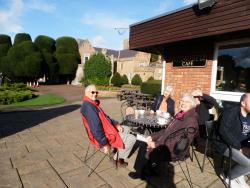
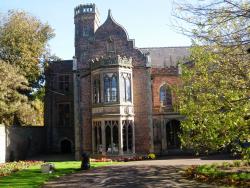
However, a cup of coffee in the sun revived us and we then undertook a tour of the house.
Entrance is free and the displays and information provided are excellent. The house has been restored sympathetically and has periodic exhibitions - during our visit it was portraits of the Johnson family and a display of Women's Work in WW1 which actually showed photos from the Drill Hall in Horncastle amongst other things. There is also a very good display on life in the in the Fens with such things as Water Fowling.
We had the added attraction in the beautiful gardens of seeing the trees being shaped and cut. This gives the garden a very different look and is obviously very skilled.

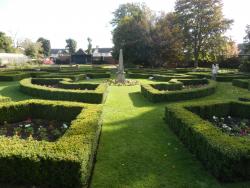
After a very good lunch in the cafe we proceed to walk the short distance to the Spalding Gentlemen's Society museum. What a wonderful cornucopia of all things collectable this is. The book collection alone runs to about 1500 books some dating from very early times. But, we also saw all the items donated over the years by Members. Some were horrific, some from far distant shows and some just plain gentlemen's interests. Words cannot begin to describe it and you would need many, many hours to take it all in. I think we all saw something that piqued our interest and we had the services of so many of their members to lead us through it. The many volunteers on hand to explain the collections were extremely good and could not have been more helpful.


As we boarded our coach back I think we were all amazed at discovering these hidden splendours of Spalding. I personally, could not have enjoyed the day more and would hope to return in the near future.
Mary Silverton
Chairman
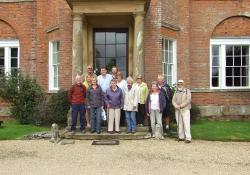
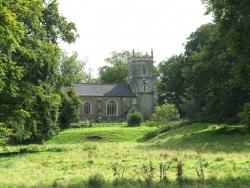
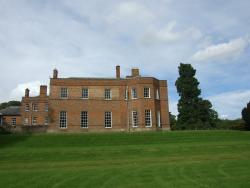
Horncastle History & Heritage Society Outing
On a lovely sunny
August afternoon, a small group of members took the opportunity to visit the
South Ormsby Estate, just a few miles east of Horncastle.
The Estate has recently been sold after the same Lincolnshire family have been in residence for over 350 years. South Ormsby comprises some 3000 acres and some exciting plans are in place: do visit their website for more details – www.southormsbyestate.co.uk.
Our tour was guided by
Caron and her knowledge and enthusiasm was very impressive: she told our group
about the house and its architecture, the artworks and the Massingberd-Mundy
family history. The Estate has been
purchased in its entirety – furniture, books, photographs and documents so
there is to be much cataloguing to be done, with some restoration works already
taking place. An especially delightful
feature is the staircase by Lumby, which Pevsner described as the chef d’oeuvre.
Our group also visited
the walled garden, the newly cleared ice-house and finally the quaint parish
church, St Leonards, where one of our members, Tricia, had first-hand knowledge
about the kneelers (Tricia had worked on them herself so what better guide!).
The many trees in the
landscape are magnificent, including at least one Wellingtonia, and it’s
encouraging to see a local Estate receiving such a renaissance, with much
attention to detail to ensure restorations are "in-keeping”. As a History and Heritage Group, it was
fascinating for us to see the Hall in its "before” condition and we shall watch
progress with interest.
There is also a plan to
look at the nearby medieval deserted villages – if you are interested in joining
such a group to add your own expertise and experience, please contact South
Ormsby Estate on caron.ementon@southormsbyestate.co.uk
Christine Chapman
August 2017
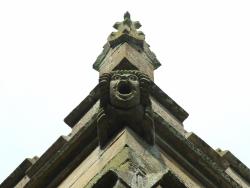
SUBJECT: FREEDOM, JUSTICE & EQUALITY
HORNCASTLE'S HORRID HISTORY
Exhibition at Chatterton's Solicitors offices, 5 South Street, Horncastle
Sunday 10th September 2017, 10.00.am to 4.00pm
Display by Ruth Addison about the folk of Horncastle who were 'transported for life beyond the seas'.
The Petty Sessions registers from the early 1800's donated to the Society Archives by Chattertons Solicitors were on display and showed us what they did to deserve such a life changing sentence.
We discovered that some of them were part of the lawlessness that took place at the Horncastle Horse Fair.
A wonderful slide show of photographs from the archives compiled by Chrissie Chapman showed how this massive annual event attracted dealers from all over the world but also attracted the petty criminals to take advantage of them. A wonderful visual display that we hope to see again in the near future.
VICTORIAN POLICE CELLS TOUR
The Police Station, The Wong, Sunday 10th
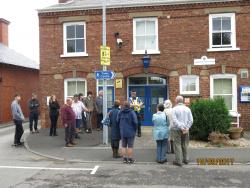
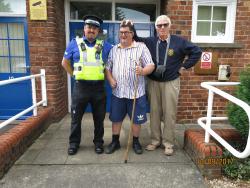
By kind permission of Lincolnshire Police. Not normally open to the public .
This was a unique opportunity to visit the Police cells of what is still a fully functioning Police station. PCSO Nigel Wass kindly conducted 4 Tours throughout the day and visitors were very impressed with his knowledge of the building and its history. We were also fortunate to have on display a model of the Police Station as used by Hornby Railways. Despite asking people to book, we had to turn away many who had failed to do so, or left it too late. A very popular event.
MYSTERIOUS ROMAN SETTLEMENT
Two guided walks of the Roman walls by Sheila Jonkers, one of our most knowledgeable members on this subject took place on the Saturday and as always received good support from the public.
The questions of why were the walls so big, and what kind of settlement was here have still not been answered.
The Society has arranged for the exhibition which took place at Lincoln Castle at the same time as 'The Poppies', will be available to view at Stanhope Hall, Boston Road, Horncastle on Sunday 30th April from 10am to 4pm.
Through themed banners you can discover the personal stories and experiences of Lincolnshire people on both the battlefield and the home front, often in their own words. Themes will include:
- The 100th anniversary of the Battle of the Somme,
- The contribution that Lincolnshire made to the war effort with its aviation industry and developments and production of the first tanks,
- The changing roles of women,
- Care of the wounded and much more.
There will also be an opportunity to see the individual stories of the 131 men from Horncastle who died in the War and the book 'Horncastle's Great War' will be available for sale.
Refreshments will be available at a small charge, but entrance will be free.
The venue is fully accessible.
|
THE HISTORY OF SMUGGLING
ON THE N.E. LINCOLNSHIRE COAST PRESENTATION BY RICHARD D’ARCY Did we really have smugglers in
Lincolnshire? When was this? Where did they come from and what
did they smuggle? Find out more at Admiral Rodney Hotel WEDNESDAY 15th MARCH 2017 7.30pm Everyone NON- MEMBERS £2
|
On the evening of Wednesday January 18th at 7.30 at the Admiral Rodney Hotel in Horncastle, retired broadcaster, film producer and railway historian, Mike Fowler, gave an excellent presentation titled: "'The Origins, Development and Decline of the East Lincolnshire Railway".
Mike is an avid collector of railway signs and an authority on this particular line as he grew up in Firsby and watched many of the trains which connected to Grimsby and Peterborough, from steam trains through to the diesels. He showed how each part of the line developed and how it was paid for. He showed a very emotive film of steam trains using the line and photos of the many passengers who used the junction to travel to Skegness and Mablethorpe for their holidays.His presentation attracted an audience of over 60 people on a very foggy night, but all agreed that it was well worth coming out. He is currently working on a presentation about the branch lines, which will include the Horncastle and Woodhall line and he was persuaded to come back to see us again next March to show this work.
Opened in 1848, this major railway route linked Grimsby with Peterborough and onwards to London. It provided for 122 years a fast route both north and south for the larger communities in Louth and Alford and the smaller rural communities in the Wolds and Fens. Via several branch lines it connected with Lincoln, Bardney, Horncastle, Skegness, Spilsby and Mablethorpe. A seven year survival struggle took place from 1963 but eventually the 73 mile route closed in October 1970.
The decision to have two stalls at the market certainly paid off. As we had the new book to sell, it was felt we needed more space for people to browse rather than enter the melay that is the chocolate tombola.
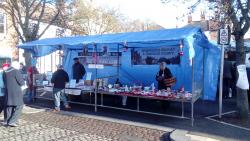 | 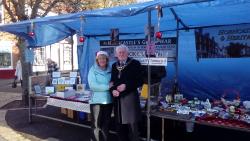 |
| Colin & June await customers | Mayor, Bill Aron with Mary |
Both stalls took over £350 and made our investment worthwhile. Thanks as always to our supportive members who donate all the chocolate and also all those who helped either settting up the tombola, or at the actual fair.
Our October outing was a visit to Gainsborough Old Hall. We were accompanied by the Horncastle U3A History Group who helped us to fill the bus.The Hall is over five hundred years and is one of the best preserved medieval manors in England.
On arrival at Gainsborough, we got a glimpse of the structure of the building, it being a mixture of timber framework in the older part, but later encased in brick as during this period brick was a statement or wealth.
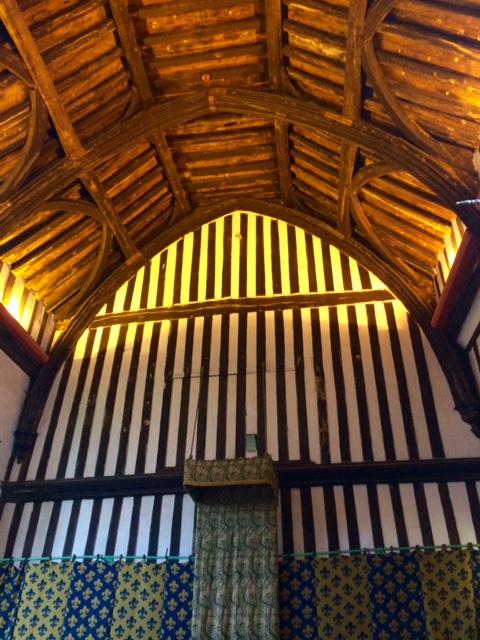
Following our pre-arranged lunch we met up with our excellent lady guide in the Great Hall. We were soon to learn that she was well acquainted with the history of the second half of the 15th century. The Hall was built in c1460 by the 1st Lord Burgh who inherited the previous manor. The Great Hall and kitchen were built first, followed by the East Range, the West Range and lastly the brick Tower, in the 1480’s.
_P250.jpg)
During our tour we were taken into what is described as the best preserved example of a late medieval kitchen. We learned that in those days they cooked everything apart from bread, which was made elsewhere in the town for fear of fire. Our travels also took us to several rooms, all appointed with the period furniture. Some of our more able bodied braved the fifty-nine step climb to the tower where a splendid view of the town awaited them.
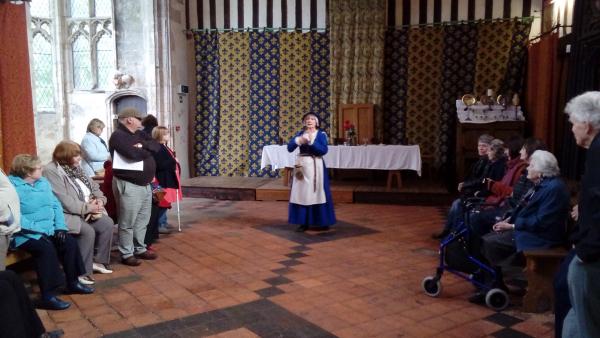
Our guide mentioned many prominent people from The War of the Roses era, who had visited the Hall, such as Edward IV, a man of immense height, and Edward’s brother, Richard III, responded to Lord Burgh’s invitation in 1483. Henry VIII also visited in 1541 towards the end of his realm
Two family dynasties help shape the Old Hall, the Burgh’s until 1596 when the 5th Lord died without an heir, and the property was sold to the Hickman and Bacon family who remained there until 1720. William Hickman and his mother supported the Separatist movement and allowed them to meet and worship from 1603 until they sailed to Holland from Boston to find religious freedom. Other members of the family were prominent members of Parliament.
Since 1720 the Hall has been put to several uses. In 1760 it became a coarse linen factory, and since a theatre, a public house, and a masonic temple. In 1949 the Hall was looked after by a volunteer group, who saved the building and opened it to the public. Sir Edmund Bacon gave it to the nation in 1970. It is now owned by English Heritage and open to the public as a museum.
Members of HHHS were pleased to be asked to be involved in the design of sculptures for the Memorial Garden at RAF Ingham. It was to honour all those who fought and fell, whilst serving at RAF Ingham and in the Bomber Squadrons of the Polish Air Force during the Second World War.
The horse statues in Horncastle had been admired by Mr Geoff Burton, founder of RAF Ingham Heritage Group and he enlisted David Lawrence, David Birchall and Bob Wayne to construct a sculpture showing Polish airmen looking out over the landscape prior to flying out on a raid.
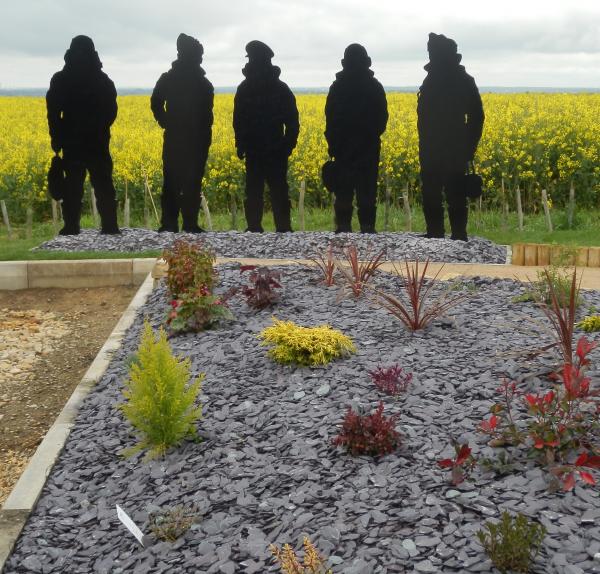
On Thursday 26th May 2016, we were invited to attend the dedication ceremony by the Consul General of the Republic of Poland, Mr Lukasz Lutostanski. The event was attended by dignatories from the County, the Polish Ambassador and representatives from the RAF and the Polish Air Force, as well as many families of Polish airmen.
It was a very moving event, especially when the list of airmen form RAF Ingham was read out. These included Canadian, australian and British servicemen as well as the Polish airmen from 300, 301 and 304 Squadrons.
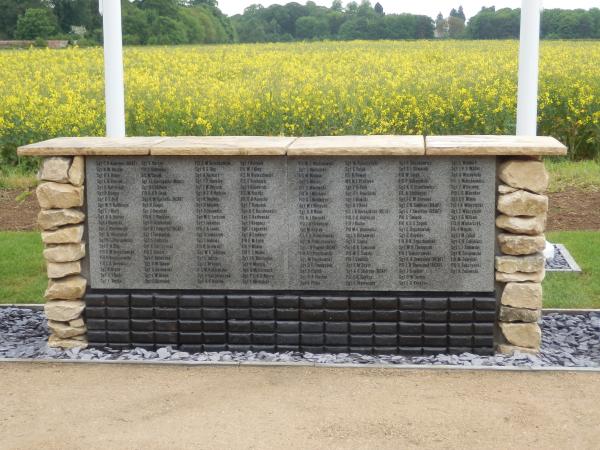
Standards of regiments were displayed, wreaths were laid by many people and the National Anthems of the countries involved were played. The Polish people present sang their anthem and it was very touching.
There was also a magnificent flypast by an RAF Jet which can just be seen in this picture.

The RAF Ingham Heritage Group have done a wonderful job but have much more work to do to create a full exhibition centre at the site. If you get chance to visit, it is worth while.
The day concluded with a lovely buffet lunch at Hemswell Cliff Hotel which was the Officers' Mess during the war. A display about RAF Ingham and the Polish Air Force was on view.
This picture shows David Birchall alongside the sculptures of which their creators should be very proud. Unfortunately, David Lawrence and Bob were unable to attend.
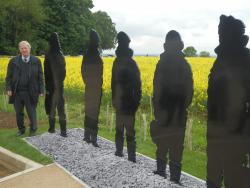 |  | 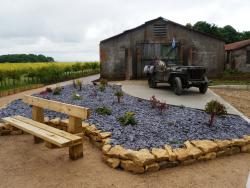 |
Len's talk on the 18th November attracted our largest audience yet with over 50 people present, and quite a few non-members.
He talked first of all about the history of the RAF and the setting up of many stations in the county, which has now reduced to just three. He talked us through the early days and the types of aircraft seen in the county over the 70 years, including the noisy Phantom. The elegant Vulcan and the plane most associated with Lincolnshire, the Lancaster. He told us that aircrews from Lincolnshire were involved in every major air engagement in WW2.
He went on to describe the social impacts of having a huge station like Coningsby on the doorstep - the noise, which the RAF originally treated as just an acceptable nuisance, but also the value of the camp to the local economy. Also the number of RAF personnel who then settle in the area. He described how Coningsby was once a major part of the local community with camp bonfires, open days, OAP's Xmas dinners, galas, etc. The latter part of his talk was about his time with the Memorial flight and the royal visitors and organising national events. A wonderful photo of the Lancaster dropping poppies down The Mall on VE Day commemoration was his final shot.
Everyone said how much they enjoyed this talk and very much appreciated the time and research that had gone into it. We also felt that there was another 10 stories for every one that Len told us.
He hopes to produce a book about RAF Coningsby and we will keep you informed.
Henry Winn from Fulletby - known as a poet and historian, but also for his amazing amount of work in the village and Lincolnshire. Find out more about the Grand Old Man of Lincolnshire.
A very successful Tudor based event as part of the National Heritage Open Day programme showing Tudor life and how Henry VIII's proposed changes to the church were received by the people of Lincolnshire.
There were over 250 visitors to the event and expenses were covered and a donation made to St Mary's Church of £90.

The full story of the Lincolnshire Rising was given in an easy to read story and diary format. The changes to church envisioned by Henry were seen through the eyes of 'Agnes' a young woman of the time and this provided some fun but also gave a deep picture of life and the church at that time.
The Monarch's Champion's armour dating back to the 16th century was on display by kind permission of the Dymoke family together with well researched documents regarding their family at that time. It is thought that the armour was taken from the church by the rebels, but later returned.
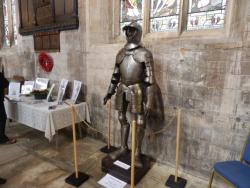

A replica of the Rebel's banner had been made and hung in the church and provided an eye catching display.

The accompaniament of live Tudor music on the recorder and delightful singing added to the atmosphere in the church.
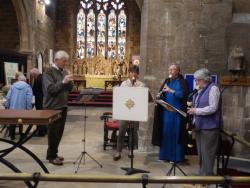
Children were catered for with Tudor craft items such as jesters on sticks etc and outdoor games such as skittles .
A display by a local bee keeper who had managed to obtain hives from Tudor period was particularly interesting.
There were also very old Latin and early English Bibles on display
A successful and informative event.
The Society entered the horse statues in the Civic Design Awards. We did not win any prizes but were surprised at the high standard of the projects that were entered and we felt we were a little out of our depth. The overall winners were Gloucestershire Service Station and most of the other winners were multi million pound projects.
However, it proved very interesting and The Chairman and Secretary enjoyed the visit to London and met some interesting people at the event, including a group who had been responsible for the installation of a dam project similar to the one planned to alleviate the floods into Horncastle, which is working successfully, we were pleased to hear.
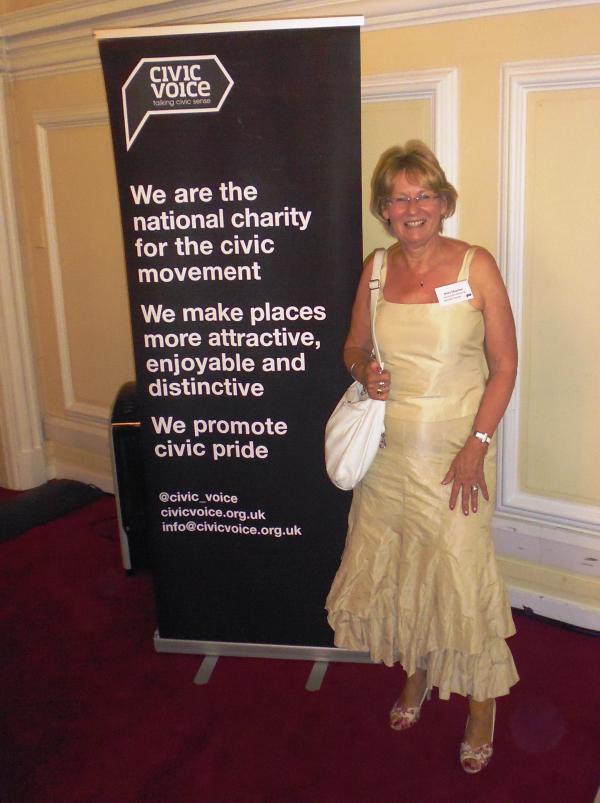
Mary Silverton at the Design Awards
15th July 2015
The walk started at the Market Place and took a route along Bridge Street, West Street and down past the Swimming Pool and back along Wharf Road. We saw the sites of the huge warehouses and the homes built to house the owners and their workers along the route. We heard about the impact on the population of the town of the canal coming and that it was because of the improved economy that the railway came here later and so eventually destroyed the canal.
About 15 members of Rotary accompanied us on this trip and afterwards several of our members joined them at the Admiral Rodney for a Pasta meal and convivial conversation.
A short talk and film on this remarkable man will take place at the Admiral Rodney Hotel on Wednesday 18th March 2015 at 7.30pm.
Non- members are also welcome to attend.
Members worked hard to present an attractive stall at the Christmas Fair on November 30th. A large selection of chocolates and chocolate cakes for the Tombola attracted the crowds, and those who couldn't eat chocolates took part in the 'guess the square game' devised and drawn by our own David Lawrence, for the wonderful basket of fruit donated by Johnson's. We also sold some scarves and jewellery and pictures of old Horncastle and this all helped to raise the wonderful sum of £335.
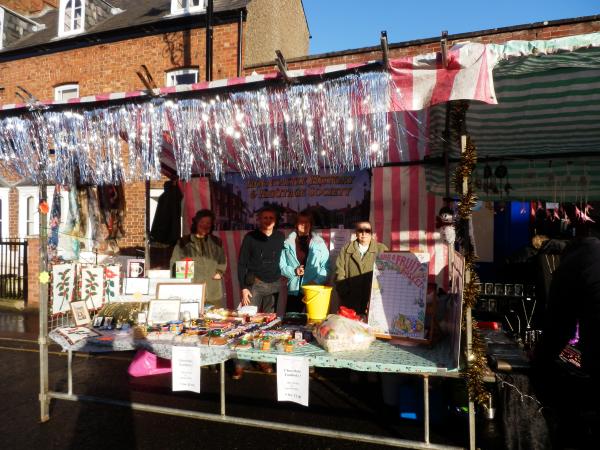
Not the most successful coffee morning
Despite the efforts of a lot of our Members the coffee morning attracted very little interest from the population of Horncastle. We had lots of books, cakes, pictures of historic Horncastle and a good display on the floods of Horncastle and a terrific raffle. But we did not have the people for some reason.
At the end of the day we raised just £62 from which the hire of the Community Centre must be taken, so not a lot of return on our efforts.
We must aim to do a bit better at our stall on the Christmas market on the 30th November. Your ideas for the stall would be very welcome to the Executive Committee.

As part of our research for the Horncastle Great War event and its legacy, a group comprising Members of HHHS, the U3A and The Lions visited the exhibition at Lincolnshire Life Museum.
The 3 hours we spent there were hardly enough to explore the museum fully. The WW1 exhibition focuses on the Lincolnshire Regiments in the war, as the site was originally their barracks, and on local family memories. It provided us with many ideas for our own displays.
After lunch at the very reasonably priced café, we enjoyed reminiscing over the displays of life as it used to be, and sometimes unfortunately, as some of us remembered, the displays of shops, homes and work places were excellent.
The WW1 exhibition continues until the 4th January 2015 and is well worth a visit. Entrance is free.
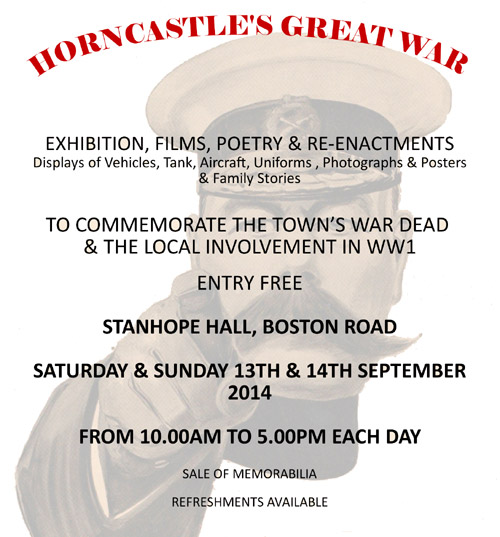
Several groups within the town (see below) have been working for a year now on an event that will truly represent the ways in which Horncastle and its immediate surrounds were affected by the First World War.
A great deal of research has been undertaken into such things as the effects on agriculture, the changes to women working, the possibility of influxes of Belgian Refugees, the effects of the Spanish Flu at the end of the war and whether the population of the workhouse was affected by returning soldiers or widows etc. Some of the answers to these questions have been surprising and you can find out at this event on Saturday and Sunday 13th & 14th September at the Stanhope Hall.
We also have for your interest a display of uniforms of the First World War, replica guns, and even a full sized model tank. There will also be a trench scene and a hospital scene set up and acted by the Theatre Company and a collection of Horncastle Newspapers for all the war years and other memorabilia.
In the Meeting Room there will be a rolling programme of films, including one about the Grimsby Pals, and some Lincolnshire dialect poetry readings and music.
On Saturday afternoon there will be a flypast by a Dakota and on Sunday we will conclude the day with a Drumhead service of remembrance by the Royal British Legion.
Of course, the main part of our event will be remembrance of the Horncastle soldiers who died or were injured in the war and each soldier will have a personal record of their war time activities and family memories on display. If your family is not local, we have a facility available on the day to find out about your ancestors and their part in the war.
We have been fortunate enough to obtain Lottery funding for this event so entry is free and we hope you will come along and find out a little more about this time and, like me, learn perhaps the true horror and sacrifices made by so many young men.
|
|||||||||||||||||||||||||||||||||||||||||||||||||||||||||||||||||||||||||
Horncastle Cyclists visit the Western Front
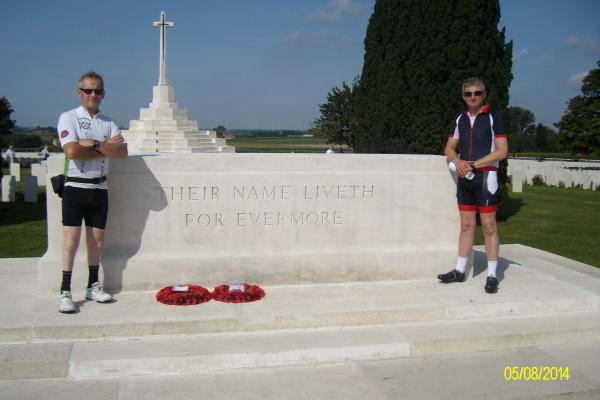
As part of Horncastle's WW1 commemoration, keen local cyclists Graham Silverton and Pete Richardson, known collectively as 'Team Bloke', forged a direct link with the Western Front by riding a 350-mile route across Belgium and Northern France, visiting key battlefields, cemeteries and memorials. Their aim was to locate and photograph the resting places of 27 of the town’s fallen who lie between Ypres and Compiegne.
Their first lap ended at the Menin Gate at Sundown on August 4th - the exact date on which Britain entered the Great War - with a parade, laying of wreaths and of course 'the last post'. Their route then took them to Tyne Cott Cemetery, Loos Memorial, Vimy Ridge, Arras Cemetery, Theipval Memorial, Villiers Bretonneux (Australian National Memorial) and Compiegne, where the Armistace was signed. The tour finished in Paris with, as Graham said, "A lot of recovery beer!".
During their 5-day Tour, Team Bloke succeeded in tracing and photographing the inscriptions commemorating the 27. The results will be on show during the Horncastle's Great War event.
Said Peter: "Finding our 'boys' and paying our quiet respects added a great sense of purpose to the ride. Of course, many more townsmen fell in other locations across this huge area." Graham agreed: "It was a privilege and pleasure to find and remember the 27 amongst the many, many thousands."
'Team Bloke' will be present throughout Horncastle's Great War, along with their cycles and a short visual presentation of their tour.
| Groups and Individuals Involved |
|
Horncastle History & Heritage Society Horncastle U3A Royal British Legion Horncastle Lions British Red Cross Horncastle Theatre Group Sir Joseph Banks Society Bartletts Battlefields Tours Leighton Shaw |
| Sponsors |
|
War Memorial Hospital Committee Horncastle Freemasons Heritage Lottery Fund |
7.30pm Wednesday 10th September 2014
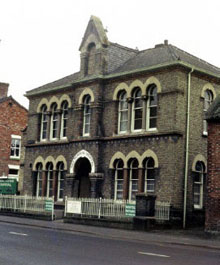 First World War
First World War
Memorials Of Lincolnshire
Presentation & Display
By Mike Credland
To start our Commemoration Weekend of Horncastle's Great War at Horncastle College, Mareham Road, at 7.30pm on Wednesday 10th September 2014.
Non Members £2.00
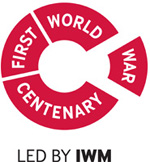 |
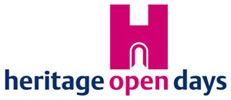 |
A very successful presentation. Mike talked about the 295 Memorials in Lincolnshire and their architects and designs. He also described the thought that went into the battlefield memorials in France & Belgium, the use of Portland Stone and the quote by Rudyard Kipling on all the memorials 'Their Name Liveth for Evermore'. His recent book 'War Memorials of Lincolnshire' was available for sale at the meeting. It was a fascinating and informative evening.

Press Release from Horncastle Civic Society
A group of Horncastle Civic Society members enjoyed a most interesting visit to Lincoln's historic Guildhall on Thursday 6th of September. To set an example of civic responsibility and reduce their carbon footprint the group elected to use public transport. Their trip started therefore in Horncastle Market Place when the Chair Mary Silverton led her party aboard a purple No 6 bus.
At Lincoln the party of sixteen were welcomed by the Mayor's Officer Joe Cooke. The conducted tour started with the Society sitting around the highly polished table in the Council Chamber. Having no useful business to conduct they were then called to order by the ringing of the 14C bell and proceeded via the robing room to inspect a display of seals including the City Charter dating back to 1157.

The visit concluded in the strong room in front of the magnificent display of city plate and regalia said to be one of the country's finest. The priceless display included the sword presented to Lincoln by Richard ll in 1387 and examples of 20th century weaponry in the form of solid silver models of HMS Lincoln together with Lancaster and Vulcan bombers presented by local RAF stations.
The Guildhall is open for free conducted tours most Fridays and on the first Saturday of each month and the Civic Society would certainly recommend a visit. To make it a really fun experience, get a group of friends to join you travelling by bus, quick, clean and devoid of parking problems.

For more information contact Mary Silverton, Society Chairman, on 01507 523091.
Submitted by Bob Wayne 01507 527366.
The Civic Society was very pleased to welcome Sheila Jonkers to their meeting on the 1st August at the Admiral Rodney.
Sheila gave an illuminating talk on what life was like for ordinary Romans and the people in the many counties they conquered. Despite their war like appearance, they appeared not to disrupt the everyday life of Celts living in rural Britain during their occupation, but their legacy is still felt today.
We owe them our written language, urban living, our roads, parts of our democracy, many of the words that we use every day, and certainly the use of Latin as the universal language for medicine, plants, etc.
Her talk was not about the facts and figures that many of us know from our school days, but Sheila managed to illustrate to the Society what every day living was like in those times, the format of their villas, their family groups, their use of slaves, their eating habits and their bathing and toileting habits.
